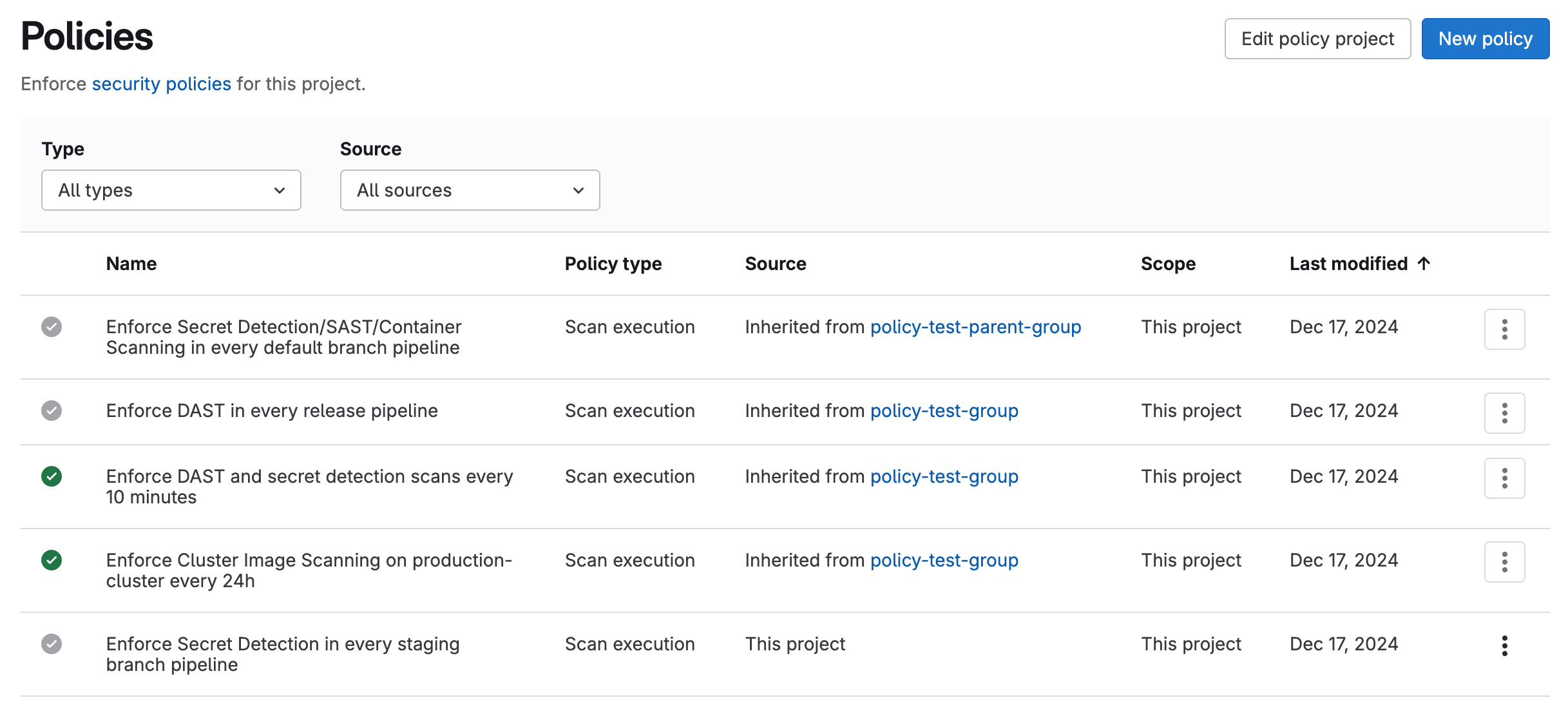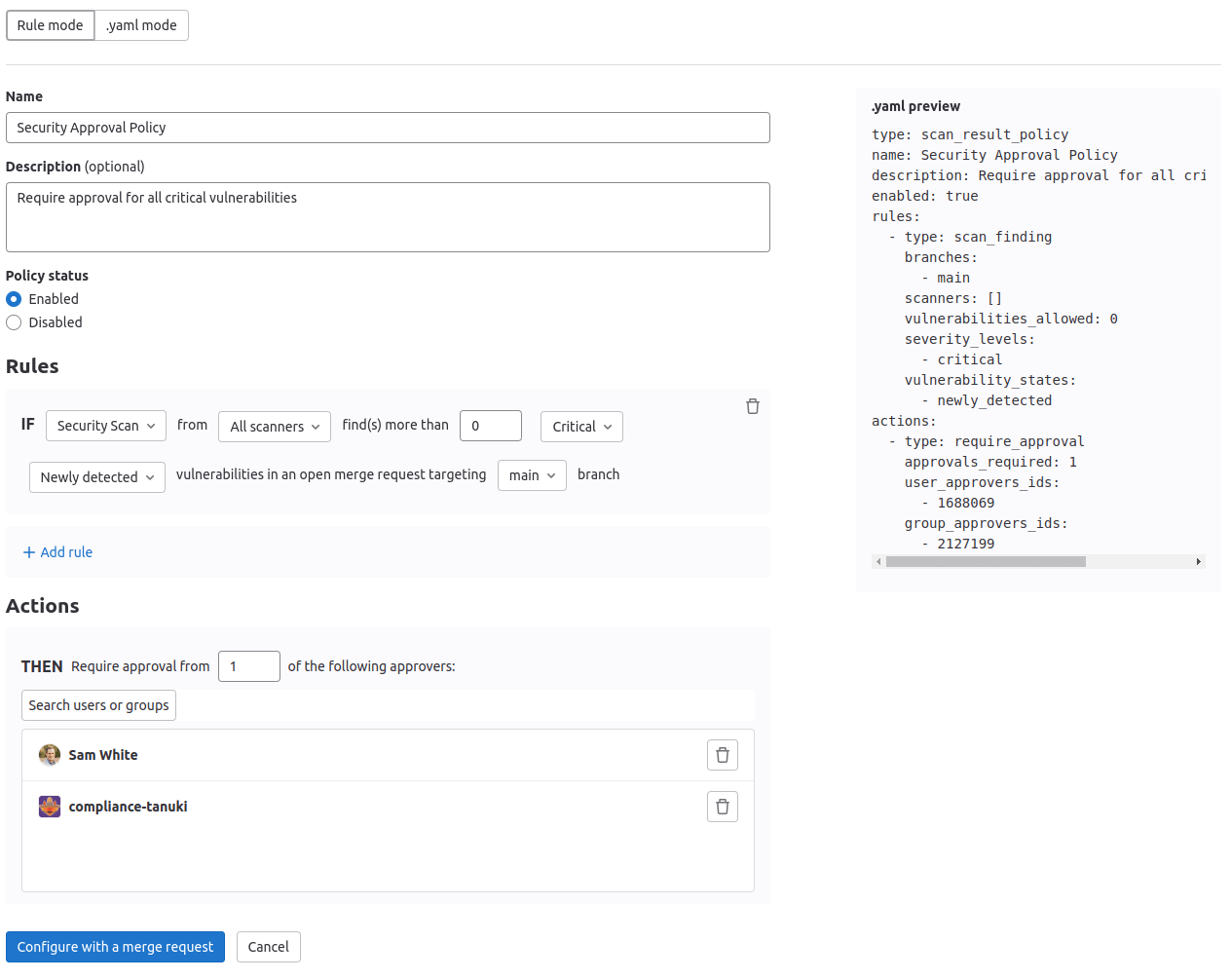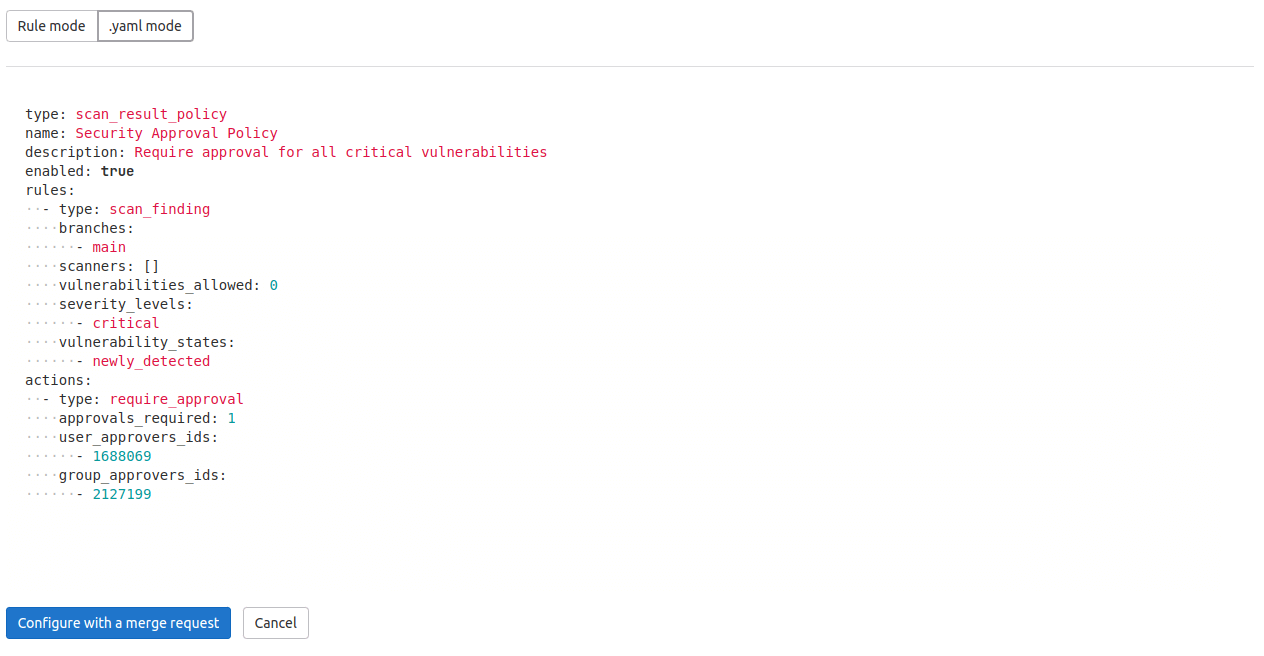Policies
- Tier: Ultimate
- Offering: GitLab.com, GitLab Self-Managed, GitLab Dedicated
Policies provide security and compliance teams with a way to enforce controls globally in their organization.
Security teams can ensure:
- Security scanners are enforced in development team pipelines with proper configuration.
- All scan jobs execute without any changes or alterations.
- Proper approvals are provided on merge requests, based on results from those findings.
- Vulnerabilities that are no longer detected are resolved automatically, reducing the workload of triaging vulnerabilities.
Compliance teams can enforce:
- Multiple approvers on all merge requests
- Projects settings based on organizational requirements, such as enabling or locking merge request settings or repository settings.
The following policy types are available:
- Scan execution policy. Enforce security scans, either as part of the pipeline or on a specified schedule.
- Merge request approval policy. Enforce project-level settings and approval rules based on scan results.
-
Pipeline execution policy. Enforce CI/CD jobs as part of project pipelines.
- Scheduled pipeline execution policy (experiment). Enforce custom CI/CD jobs on a scheduled cadence across projects, independent of commit activity.
- Vulnerability management policy. Automatically resolve vulnerabilities that are no longer detected in the default branch.
To enforce policies across multiple projects, use security policy projects. A security policy project is a special type of project used only to contain policies. To enforce the policies from a security policy project in other groups and projects, link to the security policy project from groups or other projects.
Policy design guidelines
When designing your policies, your goals should be to:
- Design policy enforcement for minimum overhead but maximum coverage
- Ensure separation of duties
Enforcement
To enforce policies to meet your requirements, consider the following factors:
- Inheritance: By default, a policy is enforced on the organizational units it's linked to, and all their descendent subgroups and their projects.
- Scope: To customize policy enforcement, you can define a policy's scope to match your needs.
Inheritance
To maximize policy coverage, link a security policy project to the highest organizational units that achieves your objectives: groups, subgroups, or projects. A policy is enforced on the organizational units it's linked to, and all their descendent subgroups and their projects. Enforcement at the highest point minimizes the number of security policies required, minimizing the management overhead.
You can use policy inheritance to incrementally roll out policies. For example, when rolling out a new policy, you can enforce it on a single project, then conduct testing. If the tests pass, you can then remove it from the project and enforce it on a group, moving up the hierarchy until the policy is enforced on all applicable projects.
Policies enforced on an existing group or subgroup are automatically enforced in any new subgroups and projects created under them, provided that all of the following are true:
- The new subgroups and projects are included in the scope definition of the policy (for example, the scope includes all projects in this group).
- The existing group or subgroup is already linked to the security policy project.
GitLab.com users can enforce policies against their top-level group or across subgroups, but cannot enforce policies across GitLab.com top-level groups. GitLab Self-Managed administrators can enforce policies across multiple top-level groups in their instance.
The following example illustrates two groups and their structure:
- Alpha group contains two subgroups, each of which contains multiple projects.
- Security and compliance group contains two policies.
Alpha group (contains code projects)
-
Finance (subgroup)
- Project A
- Accounts receiving (subgroup)
- Project B
- Project C
-
Engineering (subgroup)
- Project K
- Project L
- Project M
Security and compliance group (contains security policy projects)
- Security Policy Management
- Security Policy Management - security policy project
- SAST policy
- Secret Detection policy
Assuming no policies are enforced, consider the following examples:
- If the "SAST" policy is enforced at group Alpha, it applies to its subgroups, Finance and Engineering, and all their projects and subgroups. If the "Secret Detection" policy is enforced also at subgroup "Accounts receiving", both policies apply to projects B and C. However, only the "SAST" policy applies to project A.
- If the "SAST" policy is enforced at subgroup "Accounts receiving", it applies only to projects B and C. No policy applies to project A.
- If the "Secret Detection" policy is enforced at project K, it applies only to project K. No other subgroups or projects have a policy apply to them.
Scope
Version history
-
Introduced in GitLab 16.7 with a flag named
security_policies_policy_scope. Enabled by default. -
Generally available in GitLab 16.11. Feature flag
security_policies_policy_scoperemoved. - Scoping by group introduced in GitLab 17.4.
You can refine a policy's scope by:
- Compliance frameworks: Enforce a policy on projects with selected compliance frameworks.
- Group:
- All projects in a group, including all its descendent subgroups and their projects. Optionally exclude specific projects.
- All projects in multiple groups, including their descendent subgroups and their projects. Only groups linked to the same security policy project can be listed in the policy. Optionally exclude specific projects.
- Projects: Include or exclude specific projects. Only projects linked to the same security policy project can be listed in the policy.
These options can be used together in the same policy. However, exclusion takes precedence over inclusion.
policy_scope keyword
Use the policy_scope keyword to enforce the policy on only those groups, projects, compliance
frameworks, or a combination, that you specify.
| Field | Type | Possible values | Description |
|---|---|---|---|
compliance_frameworks |
array |
Not applicable | List of IDs of the compliance frameworks in scope for enforcement, in an array of objects with key id. |
projects |
object |
including, excluding
|
Use excluding: or including: then list the IDs of the projects you wish to include or exclude, in an array of objects with key id. |
groups |
object |
including |
Use including: then list the IDs of the groups you wish to include, in an array of objects with key id. Only groups linked to the same security policy project can be listed in the policy. |
Scope examples
In this example, the scan execution policy enforces a SAST scan in every release pipeline, on
every project with the compliance frameworks with an ID either 2 or 11 applied to them.
---
scan_execution_policy:
- name: Enforce specified scans in every release pipeline
description: This policy enforces a SAST scan for release branches
enabled: true
rules:
- type: pipeline
branches:
- release/*
actions:
- scan: sast
policy_scope:
compliance_frameworks:
- id: 2
- id: 11In this example, the scan execution policy enforces a secret detection and SAST scan on pipelines
for the default branch, on all projects in the group with ID 203 (including all descendent
subgroups and their projects), excluding the project with ID 64.
- name: Enforce specified scans in every default branch pipeline
description: This policy enforces Secret Detection and SAST scans for the default branch
enabled: true
rules:
- type: pipeline
branches:
- main
actions:
- scan: secret_detection
- scan: sast
policy_scope:
groups:
including:
- id: 203
projects:
excluding:
- id: 64Separation of duties
Separation of duties is vital to successfully implementing policies. Implement policies that achieve the necessary compliance and security requirements, while allowing development teams to achieve their goals.
Security and compliance teams:
- Should be responsible for defining policies and working with development teams to ensure the policies meet their needs.
Development teams:
- Should not be able to disable, modify, or circumvent the policies in any way.
To enforce a security policy project on a group, subgroup, or project, you must have either:
- The Owner role in that group, subgroup, or project.
- A custom role in that group, subgroup, or project with the
manage_security_policy_linkpermission.
The Owner role and custom roles with the manage_security_policy_link permission follow the standard hierarchy rules across groups, subgroups, and projects:
| Organization unit | Group owner or group manage_security_policy_link permission |
Subgroup owner or subgroup manage_security_policy_link permission |
Project owner or project manage_security_policy_link permission |
|---|---|---|---|
| Group | {check-circle} Yes | {dotted-circle} No | {dotted-circle} No |
| Subgroup | {check-circle} Yes | {check-circle} Yes | {dotted-circle} No |
| Project | {check-circle} Yes | {check-circle} Yes | {check-circle} Yes |
Required permissions
To create and manage security policies:
- For policies enforced on groups: You must have at least the Maintainer role for the group.
- For policies enforced on projects:
- You must be the project owner.
- You must be a group member with permissions to create projects in the group.
If you're not a group member, you may face limitations in adding or editing policies for your project. The ability to create and manage policies requires permissions to create projects in the group. Make sure you have the required permissions in the group, even when working with project-level policies.
Policy recommendations
When implementing policies, consider the following recommendations.
Branch names
When specifying branch names in a policy, use a generic category of protected branches, such as default branch or all protected branches, not individual branch names.
A policy is enforced on a project only if the specified branch exists in that project. For example,
if your policy enforces rules on branch main but some projects in scope are using production as
their default branch, the policy is not applied for the latter.
Push rules
In GitLab 17.3 and earlier, if you use push rules to
validate branch names
ensure they allow creation of branches with the prefix update-policy-. This branch naming prefix
is used when a security policy is created or amended. For example, update-policy-1659094451, where
1659094451 is the timestamp. If push rules block the creation of the branch the following error
occurs:
Branch name
update-policy-<timestamp>does not follow the pattern<branch_name_regex>.
In GitLab 17.4 and later, security policy projects are excluded from push rules that enforce branch name validation.
Security policy projects
To prevent the exposure of sensitive information that was intended to remain private in your security policy project, when you link security policy projects to other projects:
- Don't include sensitive content in your security policy projects.
- Before linking a private security policy project, review the member list of the target project to ensure all members should have access to your policy content.
- Evaluate the visibility settings of target projects.
- Use security policy management audit logs to monitor project linking.
These recommendations prevent sensitive information exposure for the following reasons:
- Shared visibility: When a private security project is linked to another project, users with access to the Security Policies page of the linked project can view the contents of the
.gitlab/security-policies/policy.ymlfile. This includes linking a private security policy project to a public project, which can expose the policy contents to anyone who can access the public project. - Access control: All members of the project to which a private security project is linked can view the policy file on the Policy page, even if they don't have access to the original private repository.
Security and compliance controls
Project maintainers can create policies for projects that interfere with the execution of policies for groups. To limit who can modify policies for groups and ensure that compliance requirements are being met, when you implement critical security or compliance controls:
- Use custom roles to restrict who can create or modify pipeline execution policies at the project level.
- Configure protected branches for the default branch in your security policy projects to prevent direct pushes.
- Set up merge request approval rules in your security policy projects that require review from designated approvers.
- Monitor and review all policy changes in policies for both groups and projects.
Policy management
The Policies page displays deployed policies for all available environments. You can check a policy's information (for example, description or enforcement status), and create and edit deployed policies:
- On the left sidebar, select Search or go to and find your project.
- Select Secure > Policies.
A green checkmark in the first column indicates that the policy is enabled and enforced on all groups and projects within its scope. A gray checkmark indicates that the policy is currently not enabled.
Policy editor
Use the policy editor to create, edit, and delete policies:
-
On the left sidebar, select Search or go to and find your project.
-
Select Secure > Policies.
- To create a new policy, select New policy which is located in the Policies page's header. You can then select which type of policy to create.
- To edit an existing policy, select Edit policy in the selected policy drawer.
The policy editor has two modes:
-
The visual Rule mode allows you to construct and preview policy rules using rule blocks and related controls.
-
YAML mode allows you to enter a policy definition in
.yamlformat and is aimed at expert users and cases that the Rule mode doesn't support.You can use both modes interchangeably and switch between them at any time. If a YAML resource is incorrect or contains data not supported by the Rule mode, Rule mode is automatically disabled. If the YAML is incorrect, you must use YAML mode to fix your policy before Rule mode is available again.
-
Select Configure with a merge request to save and apply the changes.
The policy's YAML is validated and any resulting errors are displayed.
-
Review and merge the resulting merge request.
If you are a project owner and a security policy project is not associated with this project, a security policy project is created and linked to this project when the merge request is created.
Annotate IDs in policy.yml
Status: Experiment
Version history
-
Introduced as an experiment in GitLab 18.1 with an
annotate_idsoption defined in thepolicy.ymlfile.
To simplify your policy.yml file, GitLab can automatically add comments after IDs, such as project IDs, group IDs, user IDs, or compliance framework IDs. The annotations help users identify the meaning or origin of each ID, which makes the policy.yml file easier to understand and maintain.
To enable this experimental feature, add an annotate_ids section to the experiments section in the .gitlab/security-policies/policy.yml file for your security policy project:
experiments:
annotate_ids:
enabled: trueAfter you enable the option, any change to the security policies made with the GitLab policy editor creates annotation comments next to the IDs in the policy.yml file.
To apply the annotations, you must use the policy editor. If you edit the policy.yml file manually (for example, with a Git commit), the annotations are not applied.
For example:
# Example policy.yml with annotated IDs
approval_policy:
- name: Your policy name
# ... other policy fields ...
policy_scope:
projects:
including:
- id: 361 # my-group/my-project
actions:
- type: require_approval
approvals_required: 1
user_approvers_ids:
- 75 # jane.doe
group_approvers_ids:
- 203 # security-approversWhen you apply annotations for the first time, GitLab creates the annotations for all IDs in the policy.yml file, including those in policies that you aren't editing.
Troubleshooting
When working with security policies, consider these troubleshooting tips:
- You should not link a security policy project to both a development project and the group or subgroup the development project belongs to. Linking this way results in approval rules from the merge request approval policies not being applied to merge requests in the development project.
- When creating a merge request approval policy, neither the array
severity_levelsnor the arrayvulnerability_statesin thescan_findingrule can be left empty. For a working rule, at least one entry must exist for each array. - The owner of a project can enforce policies for that project, provided they also have permissions to create projects in the group. Project owners who are not group members may face limitations in adding or editing policies. If you're unable to manage policies for your project, contact your group administrator to ensure you have the necessary permissions in the group.
If you are still experiencing issues, you can view recent reported bugs and raise new unreported issues.


